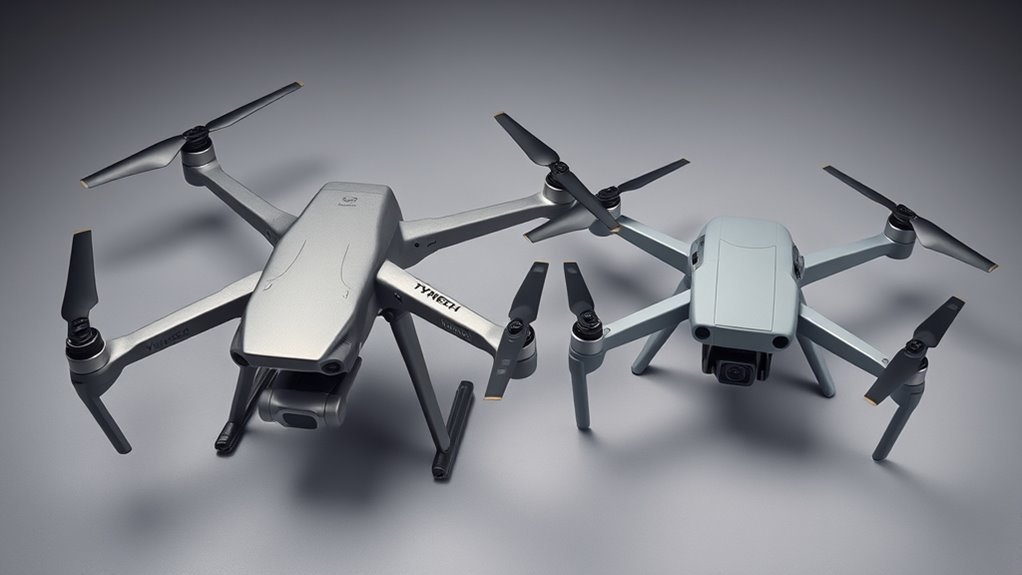When comparing the Yuneec Typhoon H’s 360-degree gimbal to the DJI Mavic 3 Classic’s Hasselblad camera, you’ll see the Typhoon H offers superior rotational flexibility for dynamic shots, capturing wide angles with its 12MP sensor and 4K video at 30fps. In contrast, the Mavic 3 Classic’s 20MP Hasselblad system delivers sharper 5.1K video at 50fps with advanced stabilization, prioritizing precision and color accuracy. While the Typhoon H excels in maneuverability, the Mavic suits professional imaging demands. Additional insights on performance lie ahead.
Key Specifications and Design
While the Yuneec Typhoon H features a hexacopter design for enhanced stability and redundancy, the DJI Mavic 3 Classic prioritizes portability with its foldable structure. Regarding design aesthetics, you’ll appreciate the Typhoon H’s sturdy, industrial vibe, which emphasizes reliability for extended flights, allowing you greater freedom in challenging environments. Its layout promotes intuitive handling, letting you focus on exploration without constraints. By contrast, the Mavic 3 Classic’s streamlined, minimalist form factor enhances your mobility, making it ideal for spontaneous outings where space is limited.
When examining build materials, the Typhoon H incorporates robust carbon fiber and aluminum alloys, ensuring durability and resistance to elements, so you can operate independently in diverse settings. Meanwhile, the Mavic 3 Classic utilizes high-grade magnesium and engineered plastics, balancing strength with reduced weight for effortless transport. This approach empowers you to pursue adventures on your terms, unburdened by bulk. Ultimately, these choices in design aesthetics and build materials reflect how each drone aligns with your desire for liberated, tailored flying experiences.
Camera Features and Imaging Quality
The Yuneec Typhoon H equips a 12-megapixel camera that records 4K video at 30fps, offering reliable imaging for general aerial photography. Its lens capabilities include a wide-angle view with adjustable focal lengths, allowing you to capture expansive scenes without distortion. You’ll appreciate the built-in image stabilization, which minimizes shakes during flight, ensuring clearer shots in variable conditions and granting you the freedom to explore without technical worries.
In contrast, the DJI Mavic 3 Classic features a 20-megapixel Hasselblad 4/3 CMOS sensor, recording up to 5.1K video at 50fps for superior detail. Its advanced lens capabilities deliver vibrant colors and precise optics, while the enhanced image stabilization—via a 3-axis gimbal—provides even smoother footage, empowering you to achieve professional-grade results effortlessly. Analytically, both drones excel in imaging, but the Mavic’s higher resolution and stabilization edge out the Typhoon H for demanding creative pursuits, letting you fly with unbridled expression.
Performance, Flight, and Value Comparison
When comparing the performance, flight capabilities, and overall value of the Yuneec Typhoon H and DJI Mavic 3 Classic, you’ll notice that the DJI model delivers superior speed and agility, reaching up to 68 mph with advanced obstacle avoidance, while the Yuneec tops out at 43 mph with less refined sensors. Regarding battery life, the DJI offers up to 46 minutes of flight time, enabling longer explorations, compared to the Yuneec’s 25 minutes, which limits your freedom in extended sessions. Control range also favors the DJI at 12 miles versus the Yuneec’s 1.6 miles, allowing you greater autonomy in remote areas. Analytically, the DJI’s technical edge in flight stability and integration enhances value for users seeking reliable performance, though the Yuneec provides a more affordable entry point if you’re prioritizing basic functionality over advanced features. Objectively, your choice hinges on balancing these factors for ideal aerial freedom.
Frequently Asked Questions
What Is the Warranty Period for Each Drone?
You’re wondering about the warranty periods for drones, as this directly influences warranty coverage and drone reliability. For the Yuneec Typhoon H, you’ll find a standard 1-year limited warranty, supporting its robust build for dependable flights. The DJI Mavic 3 Classic offers a 1-year warranty on the aircraft, with 6 months for batteries, empowering your aerial adventures with added peace of mind and technical assurance.
How Do I Register These Drones Legally?
Registering your remarkable drones requires careful compliance with legal requirements to guarantee you’re flying freely and safely. For drone registration, start by checking your country’s aviation authority—like the FAA in the US—where you’ll provide details such as your name, address, and drone specs online. It’s a straightforward process: submit forms, pay a small fee, and receive a unique ID. This step maintains airspace security, letting you explore without restrictions, but always verify local rules for full compliance.
Are There Financing Options Available?
You’re exploring financing options for your drone purchase, and yes, several are available to enhance your flexibility. Manufacturers like DJI often offer payment plans through partners such as Affirm or PayPal Credit, allowing you to spread costs over time with low-interest rates. Third-party lenders provide similar financing options, ensuring you can acquire gear without upfront burdens, empowering your aerial adventures with tailored payment plans. Always check eligibility and terms for the best fit.
What Apps Integrate With These Drones?
When you’re considering what apps integrate with your drones, you’ll encounter various drone compatibility apps and software integration options that enhance functionality. For instance, DJI’s Mavic 3 Classic works seamlessly with the DJI Fly app for intuitive control and editing, while Yuneec’s Typhoon H pairs with the Yuneec app for advanced settings. These tools offer you analytical precision, technical reliability, and the freedom to customize flights objectively, ensuring autonomous exploration.
How Should I Maintain the Drones?
Just like a bird preening its feathers for flawless flight, you’ll need to prioritize drone maintenance to keep soaring freely. For drone cleaning, regularly wipe down components with a soft cloth and isopropyl alcohol to remove dust and grime, preventing sensor failures. Battery care is vital—store them at 50-60% charge in a cool, dry place, and avoid extreme temperatures to extend lifespan and guarantee safe, liberating adventures. Always follow manufacturer guidelines for peak performance.

